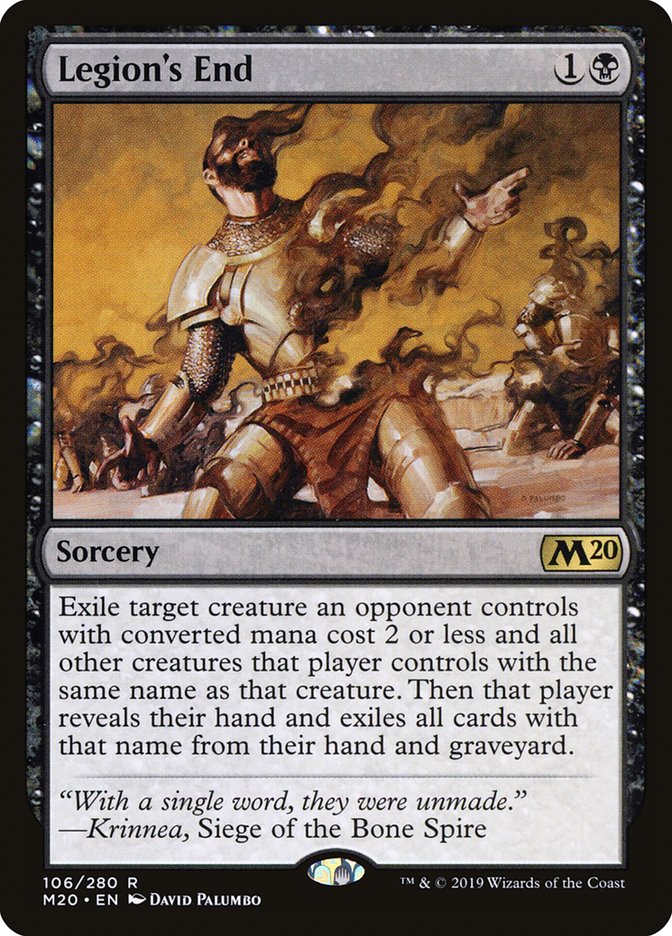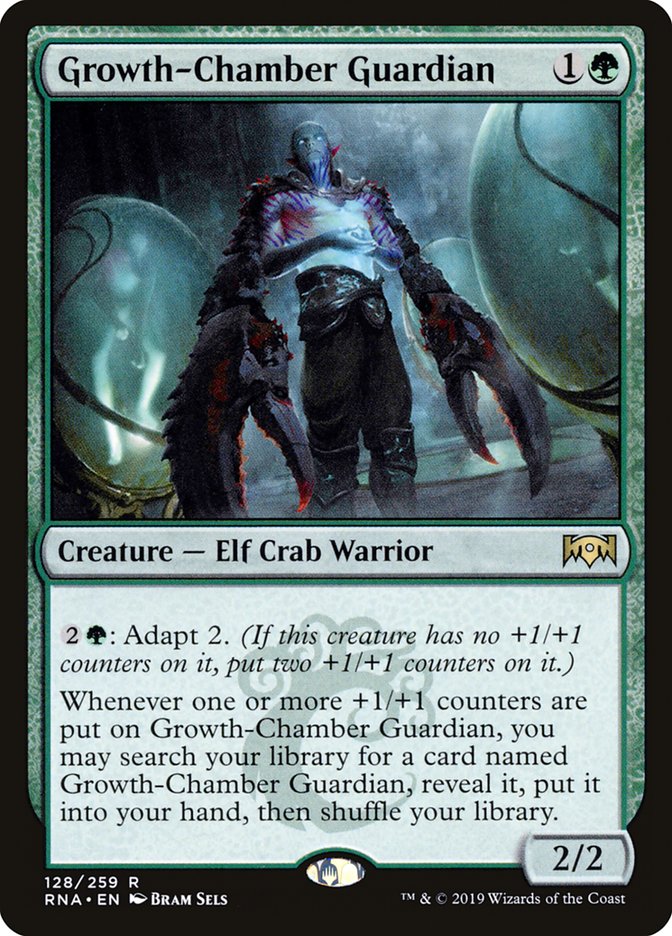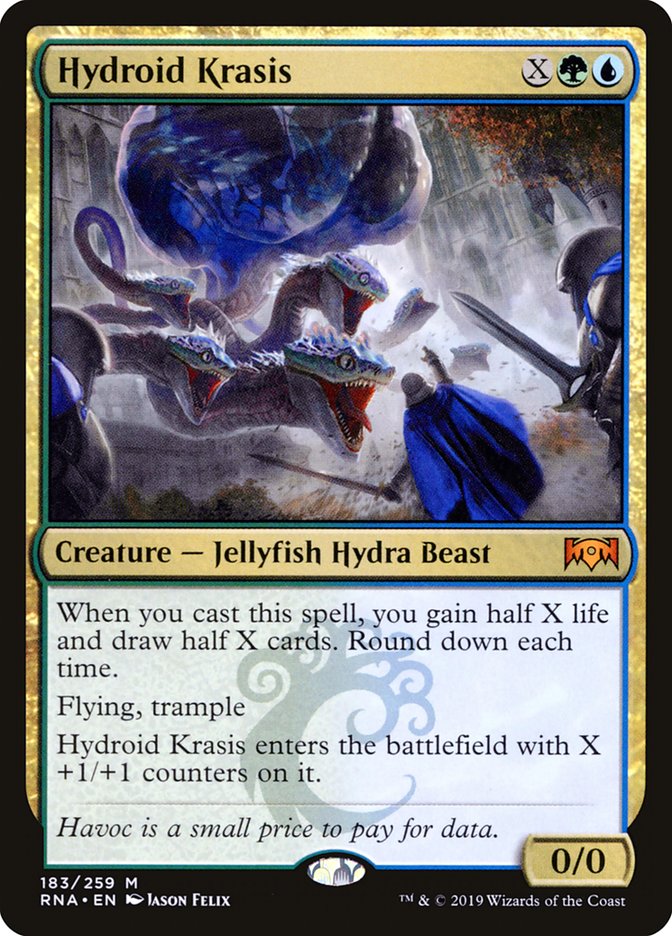Legion’s End is quite a specific effect, no?
Exiling a two-drop and all other copies on the battlefield, the hand, and the graveyard? There’s a reason this card exists, a reason that Wizards of the Coast decided to target specific types of threats with a cheap, easily played removal spell, and it’s on us to figure out what it does to Standard and Modern. After all, they gave us the card to play, and at a very attractive mana cost. Legion’s End is bound to make an impact in Standard, and might even see play in the Eternal formats, which means this is something worth examining more closely.
So, how is Legion’s End going to change things?
Legion’s End hates on a few specific cards in both formats. In Standard, obviously, the first candidate is Growth-Chamber Guardian. The massive tempo swing that Legion’s End offers us is absolutely game-winning. An opponent can invest upwards of ten mana in the early turns developing a Growth-Chamber Guardian chain, only to see their entire battlefield wiped away with a single two-mana removal spell. This means that suddenly Esper Control can basically never fall behind to the chain of Growth-Chamber Guardians, and what was formerly one of the best cards in the deck is now barely playable. That’s huge.
Additionally, what were once format-defining two-drops are all on serious watch now. Hero of Precinct One, Runaway Steam-Kin, Adanto Vanguard, Wildgrowth Walker, Merfolk Branchwalker, and even Llanowar Elves are possible liabilities in the face of a potential blowout with Legion’s End. This is a big deal for both deck design and in-game play. It provides an incredible boost to any defensive strategy by opening up the possibility of massive blowouts without any recourse from the aggro deck.
Basically, we have the Maelstrom Pulse effect going on in Standard yet again, which hasn’t been a factor in play patterns for a full decade. That gentle pressure on the format, for those who weren’t around last time it was a big factor, means that threat diversity is paramount, and occasionally it rewards players for sandbagging their extra copies of a specific threat. Getting all your Putrid Leeches or Bloodbraid Elves hit with a single Maelstrom Pulse was always a miserable experience! Legion’s End will bring back those feel-bads with a vengeance.
Critically, though, Legion’s End will rip excess copies of cards out of the hand, which means that there’s no escaping the potential for a blowout when this card exists. A simple hand with two Llanowar Elves on the draw becomes a near auto-loss when Legion’s End gets involved. It’s just an incredible beating for aggro players that such a cheap removal spell has the potential of creating such insane swings. Having a nonzero percentage of games just end on the spot by the second turn because of Legion’s End offering an occasional Mind Twist in addition to being a Cast Down is bananas.
And of course, with Teferi, Time Raveler in Standard, the sorcery speed of the spell matters less than ever before. It’s absolutely insane, getting to play the spells WotC deliberately printed with a timing drawback without said drawback because of the incidental effect of the best Reflector Mage variant ever printed. Obviously most two-drop removal spells are instant-speed, because that’s just how it’s always been – Cast Down, Tyrant’s Scorn, et al. A sorcery-speed drawback is a serious deal, but it’s not even that serious in Esper because of Teferi. I look forward to combat-step Legion’s Ends to absolutely crumble entire battlefields for a mere two mana.
Oh, and against Nissa, Who Shakes the World, an instant-speed Legion’s End will take out the animated land as well as any leftover copies in hand. It’s not much, but it is a nifty bonus that isn’t immediately obvious at first glance.
What’s to be done? The simple answer is “not much.” There’s a bit of threat diversification one can use, but the threats drop off in quality fairly quickly after Thorn Lieutenant and Zhur-Taa Goblin. Obviously Growth-Chamber Guardian is a liability if Legion’s End becomes widespread, so a mix of the less-powerful threats becomes the next best option. Gruul could pick up Merfolk Branchwalker, but it just seems relatively anemic compared to the rich two-drops we’ve been spoiled with thus far. Of course, it could just mean that Gruul Aggro is essentially knocked out of the format in favor of Mono-Red, Mono-White, and possibly Mono-Blue Aggro. Those decks are similarly vulnerable to Legion’s End, yet have an easier time diversifying or protecting their threats (or, in the case of Mono-Red, the threats are super-expendable).
And yes, decks like Simic Nexus, Bant Ramp, and various Sultai or Four-Color Dreadhorde decks can emerge to attempt to prey on Esper, but it’s going to be difficult to find a spot in the metagame invulnerable to even a small adjustment on the part of the midrange monster. Also, Hydroid Krasis is a joke now. It already got way worse now that Narset, Parter of Veils cut off the best half of the card, but now Bant Ramp decks can get their best engine piece ripped out from under them with basically no additional effort on the part of the Esper deck. Didn’t some lists play Unmoored Ego last format? Now you can have that effect tacked onto your cheap removal spell.
Esper Control (rather than Esper Superheroes, of course) becomes even better than previously, and it stands ready to cement itself as the best of the format. I’m excited to watch it evolve to combat basically everything the format throws at it, week-in and week-out. Having a Standard format converge on one dominant midrange deck is pretty rare nowadays, but the gameplay can get pretty intricate and enjoyable in the late stage of such a format. I’m ready for Esper Summer!
Creatures (2)
Planeswalkers (12)
Lands (26)
Spells (20)

(Note: It’s hard to know how to balance Temples, shocklands, and checklands. I’m sure someone smarter than me will figure out the optimal balance, but these lands are insane for hedging against flood and screw, and I fully expect to play upwards of ten at some point during their tenure in Standard.)
But Standard isn’t the only format where this effect can be of use. Obviously Bridgevine in Modern is an extraordinarily overpowered deck, but if and when Bridge from Below and/or Hogaak itself are banned, Legion’s End is the kind of removal spell that answers Bloodghast particularly cleanly while also being playable against the various creature decks of the format. Effects like this are the bread and butter of a Grixis Death’s Shadow sideboard (or Mardu Death’s Shadow, as the case may be, now that it’s won the Team Modern Open at SCG Pittsburgh).
The card is playable against the following non-exhaustive list of archetypes in Modern:
- Humans
- Spirits
- Izzet Phoenix
- Dredge (once Hogaak is gone)
- Hardened Scales
- Infect
- Mardu Pyromancer
- All Flavors of Death’s Shadow
- Golgari Midrange
- All Flavors of Devoted Druid
That’s quite a lot of coverage for a newcomer to the format. Obviously Modern is a hyper-efficient format defined by cards like Fatal Push and Thoughtseize, so a two-mana sorcery has a super-high bar to clear to be worth it. But I’m cautiously optimistic about this unique cross between creature removal and graveyard hate with just a sprinkling of blowout two- or three-for-one potential. If you get your hand full of carefully sandbagged Snapcaster Mages ripped apart by an errant Legion’s End, don’t say I didn’t warn you!
I foresee Legion’s End getting one or two spaces in certain black-based midrange decklists in specific metagames, but it’s going to require a healthy dialing back on the power level of Modern as a whole before Legion’s End is a truly profitable inclusion. After all, when free spells like Force of Negation and Surgical Extraction are maindeck staples in multiple archetypes, it takes a lot of chutzpah to play a two-mana removal spell as your “answer” to Bloodghast. If you’re among the traditionalists holding out hope for a major format reset, though, you’re going to want to put this card on your shortlist for after a barrage of bannings wipe the format clean!
Wu-Tang Financial advises us to diversify our bonds, and were there a Wu-Tang Magic Twitter account, I would not be at all surprised to hear about how it’s time to diversify our threats as well. And to be frank, that’s more than all right with me. Diverse threat bases keep games of Magic more unique and fresh. If that’s the lasting impact of a card like Legion’s End, I can forgive the potential for incredible feel-bad moments when a three-for-one on the second turn ends the game on the spot. Standard will have a brand-new guiding principle pushing things away from convergent “optimized” lists. Running four copies of multiple two-mana creatures is just not tolerable anymore, and if it means we’re going to get to see a few more oddball creatures pop up in winning lists, that is a silver lining I can live with.
Pushing threat diversity and offering counterplay to certain formerly unbeatable openings is a noble goal. If WotC gave us Legion’s End to push those angles in Standard (and, to a lesser extent, Modern), call me a cautious fan of these new incentives. Look for those two- and three-ofs to raise eyebrows in decklists going forward, and thank Legion’s End for pushing us away from consolidated decks and towards a bit of variety!






